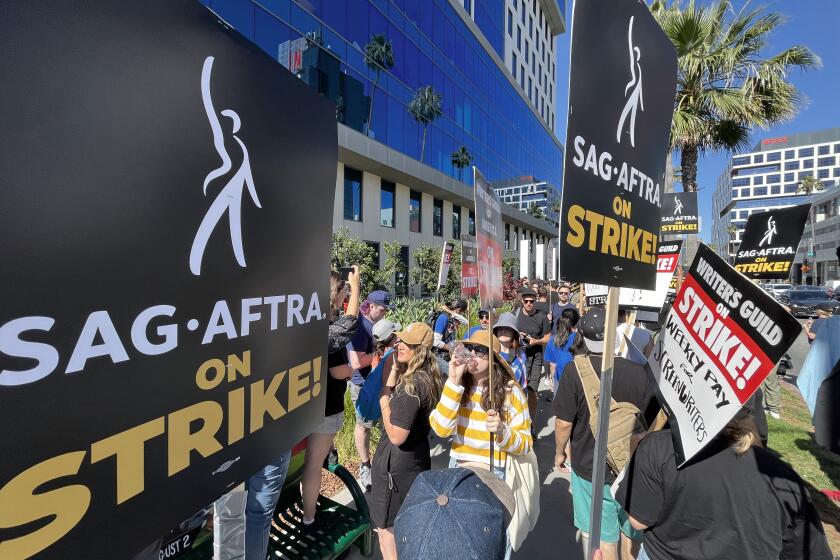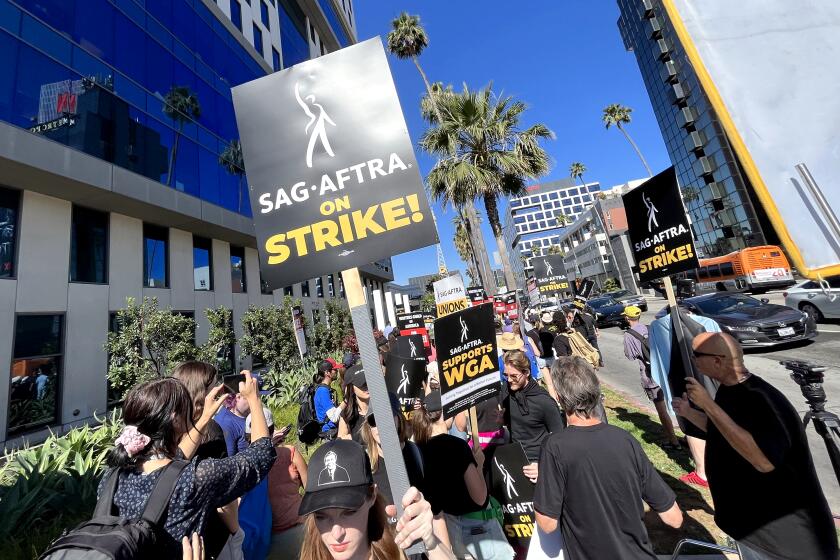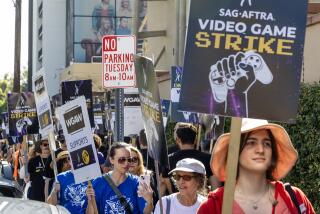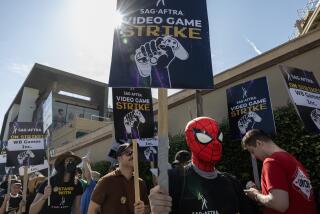SAG-AFTRA committee approves deal with studios to end historic strike
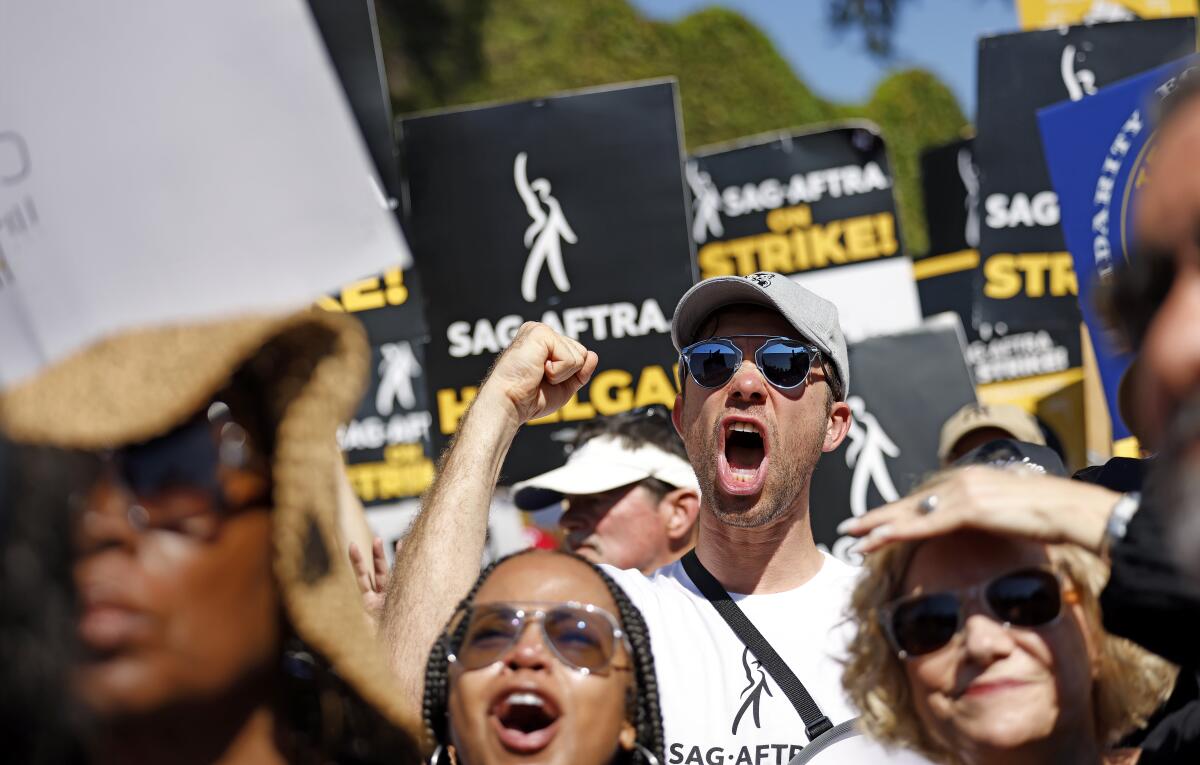
- Share via
SAG-AFTRA’s negotiating committee has approved a tentative deal with the major studios that would end a nearly four-month-long strike that has sidelined thousands of workers and hobbled much of Los Angeles’ signature entertainment industry.
The unanimous vote came Wednesday after a tense week. SAG-AFTRA leaders worked feverishly for days to improve terms of the proposed labor contract offered by the media companies, which bargain through the Alliance of Motion Picture and Television Producers. The union said the 118-day strike would officially end at 12:01 a.m. Thursday.
Actors react to SAG-AFTRA strike ending: ‘We worked hard ... didn’t cave ... got the deal we needed’
As SAG-AFTRA announced that it has reached a tentative deal with the AMPTP studios, long-striking actors react online to the historic deal.
“We have arrived at a contract that will enable SAG-AFTRA members from every category to build sustainable careers,” the guild’s television and theatrical negotiation committee said late Wednesday in a message to members. “Many thousands of performers now and into the future will benefit from this work.”
SAG-AFTRA did not immediately disclose terms of the agreement, but the committee said the three-year contract was “valued at over $1 billion.” The details are expected to be released after SAG-AFTRA’s national board reviews the contract on Friday.
The proposed contract — which also still must be ratified by the union’s members — boosts minimum pay for members, increases residual payments for shows streamed online and bolsters contributions to the union’s health and pension plans. It also establishes new rules for the use of artificial intelligence, a major source of concern for actors. SAG-AFTRA said it won “unprecedented provisions for consent and compensation that will protect members from the threat of AI.”
In a statement, the AMPTP hailed the agreement as a “new paradigm,” saying it gives SAG-AFTRA “the biggest contract-on-contract gains in the history of the union, including the largest increase in minimum wages in the last forty years; a brand new residual for streaming programs; extensive consent and compensation protections in the use of artificial intelligence; and sizable contract increases on items across the board.”
The final days of bargaining were filled with drama. Studio chiefs on Friday presented what they called their “last, best and final” offer, which the executives said addressed the guild’s demands. The two sides met Saturday afternoon to go over the proposal, and company representatives stressed that they needed movement from SAG-AFTRA to be able to salvage the current television season.
SAG-AFTRA’s negotiating committee then spent four days scrutinizing and debating the proposals.
On Wednesday, after another marathon day of internal discussions among negotiating committee members, studio chiefs gave the union a 5 p.m. Wednesday deadline to deliver an answer. The guild announced its decision 23 minutes before the deadline.
“We did it!!!!” SAG-AFTRA President Fran Drescher wrote Wednesday night in an Instagram post. “The Billion+ $ Deal! ... [Thank you] sag aftra members for hanging in and holding out for this historic deal.. [and] Our sister unions for their unrelenting support!”
The hard-fought accord ends one of Hollywood’s most fraught periods of labor conflict and the longest-ever actors’ strike.
SAG-AFTRA members walked out July 14, joining striking Writers Guild of America members and launching the industry’s first twin strikes since 1960. Writers spent nearly five months on picket lines before reaching a new contract in late September with the Alliance of Motion Picture and Television Producers.
After sealing that deal, the studios were motivated to resolve the actors’ standoff in an effort to salvage the current television season and next year’s theatrical film slate. Film executives also worried that the feature film business, which has been ailing since COVID-19 shutdowns, would struggle to recover if theaters went another year without potential blockbusters to draw moviegoers to cinemas.
Four top corporate executives — Walt Disney Co. Chief Executive Bob Iger, Netflix co-CEO Ted Sarandos, NBCUniversal Studio Group Chair Donna Langley and Warner Bros. Discovery chief David Zaslav — joined AMPTP President Carol Lombardini to hammer out a deal with Drescher and the guild’s chief negotiator, Duncan Crabtree-Ireland.
Over the weekend, heads of several other studios joined the Zoom calls with SAG-AFTRA.
Drescher, in her message, also thanked the AMPTP “for hearing us and meeting this moment!”
“I will not cave,” “The Nanny” star and SAG-AFTRA President Fran Drescher says in an interview, as the actors’ strike reaches 100 days. Talks with the major studios were suspended earlier this month.
The actors’ strike exposed deep fears over the future of entertainment employment and evolving technology.
Actors have worried that artificial intelligence could be used to create digital replicas of performers, replacing the need for actual actors in the background — a source of income for scores of performers.
The shift to streaming has disrupted the industry’s decades-old economic model. Netflix and other streaming services typically pay performers upfront, minimizing the residuals that working actors have relied on to sustain themselves between jobs. Union leaders entered the strike hoping to claw back some relief for working actors as the industry moves away from the 22-episode season that network TV orders in favor of six- to 13-episode seasons, which are more the norm for streamers.
“I will not cave and I will not let them down,” Drescher said in an October interview.
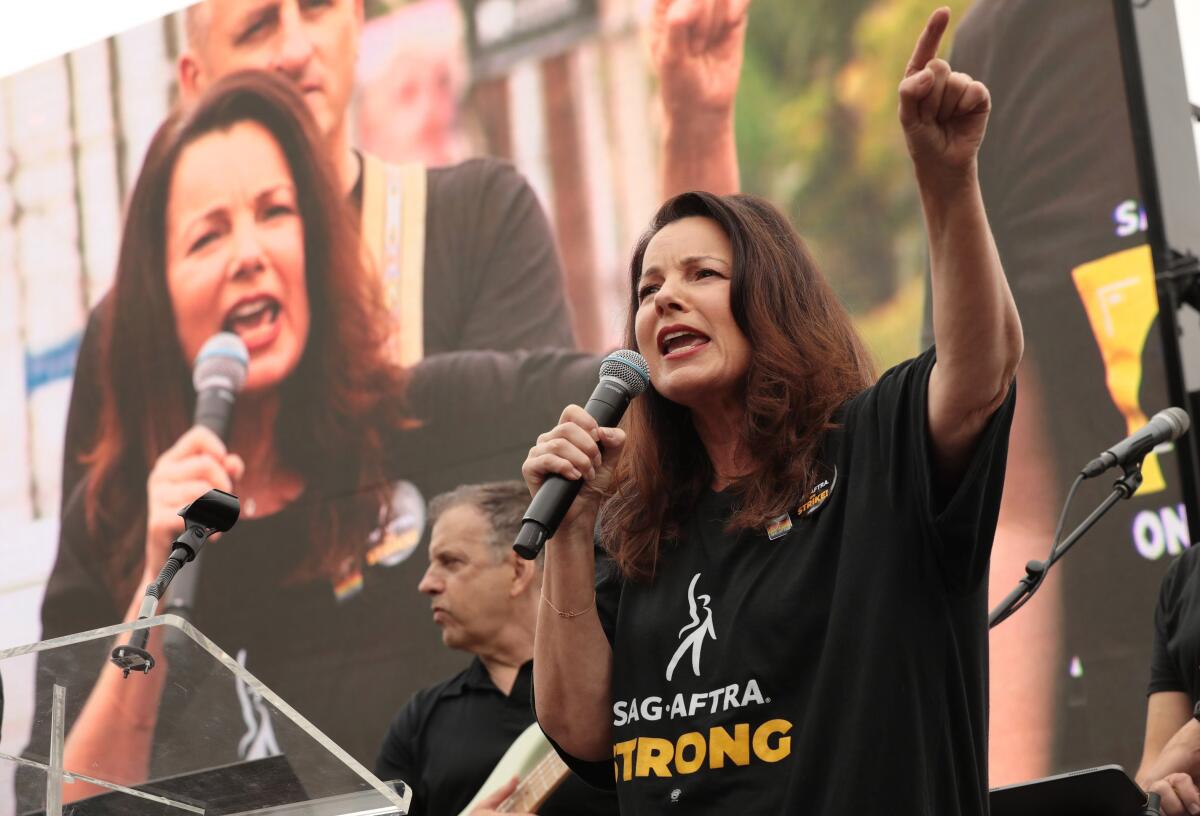
In addition to Netflix and the traditional companies, the AMPTP bargains on behalf of Amazon Studios and Apple TV.
The work stoppage dealt a devastating financial blow to film industry workers beyond members of the two striking guilds. Many workers have been without a job since April, and businesses that support the production industry also saw their sales suffer.
The U.S. Bureau of Labor Statistics reported that since last spring, more than 45,000 jobs were erased from payrolls in the entertainment and sound recording industries. The dual strikes have caused an estimated $7 billion in economic damage, according to Todd Holmes, associate professor of entertainment media management at Cal State Northridge.
Los Angeles Mayor Karen Bass said in a statement that she was grateful that a “fair agreement” had been reached.
“Today’s tentative agreement is going to impact nearly every part of our economy,” Bass said. “Now, we must lean in on local production to ensure that our entertainment industry rebounds stronger than ever and our economy is able to get back on its feet.”
How did talks between actors and studios collapse, resulting in the first strike under the film and TV contract since 1980?
SAG-AFTRA’s bargaining position was strengthened by historic solidarity. Throughout the summer and fall, actors and striking WGA members were joined on picket lines by nurses, county workers, Teamsters and members of the International Alliance of Theatrical Stage Employees, which represents film set workers. IATSE’s contract with the studios is up next year.
“The workers had more bargaining power during these negotiations so it took time for the companies to realize that they needed to yield more and meet the union’s demands,” Eunice Han, a University of Utah economics professor specializing in labor, said in an interview.
The path to a truce was bumpy. The AMPTP entered into negotiations with the actors union June 7, just three weeks before their contract was due to expire. Initially, it appeared the two sides were making progress toward a deal, but they were unable to bridge key differences, despite a last-minute move by the companies to bring in a federal mediator.
A high-profile warning by A-list actors helped set the stage for the work stoppage.
In late June, actors including Meryl Streep, Jennifer Lawrence and Amy Schumer signed a letter encouraging SAG-AFTRA leaders not to settle for anything less than a “transformative deal.” The letter, delivered at a time when SAG-AFTRA’s negotiating committee was struggling for traction in the talks, added pressure on Drescher and Crabtree-Ireland to hold out for considerable gains.
SAG-AFTRA’s contract expired June 30, but the group extended the deadline to July 12. That date came and went without a deal.
As SAG-AFTRA members join writers on picket lines, the fallout will disrupt Hollywood film and TV productions worldwide. ‘There’s going to be blood in the water,’ said one analyst. ‘This will not end well.’
After 2½ months of workers on picket lines and a virtual work stoppage for scripted television and movies, the AMPTP invited SAG-AFTRA back to the table on Oct. 2.
After five days of talks at SAG-AFTRA’s headquarters on Wilshire Boulevard, negotiations broke down on Oct. 11. The studios paused the bargaining in protest of the union’s stance on streaming revenue sharing, a sticking point throughout the negotiations. The union’s initial proposals to put guardrails on the use of artificial intelligence remained a point of contention throughout the talks, sources said.
Finally, Iger called Crabtree-Ireland to lay the groundwork to restart negotiations after a nearly two-week pause.
SAG-AFTRA has approved a deal from the studios to end its historic strike. The actors were on strike for more than 100 days.
A-list actors, including George Clooney, Ben Affleck and Scarlett Johansson, also approached SAG-AFTRA leaders to discuss ways to resolve the strike. The move prompted a separate group of actors to encourage the negotiating committee to stand firm.
“The guilds were probably thinking: ‘Let’s not give in because we’ve come this far,’” Han said. “‘If we wait a few more days we’ll probably get what we want — at least closer to what we want.’”
Negotiations resumed after the actors marked 100 days on strike.
Times staff writer Sarah Parvini contributed to this report.
- Share via
Watch L.A. Times Today at 7 p.m. on Spectrum News 1 on Channel 1 or live stream on the Spectrum News App. Palos Verdes Peninsula and Orange County viewers can watch on Cox Systems on channel 99.
More to Read
Inside the business of entertainment
The Wide Shot brings you news, analysis and insights on everything from streaming wars to production — and what it all means for the future.
You may occasionally receive promotional content from the Los Angeles Times.
